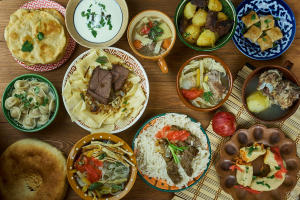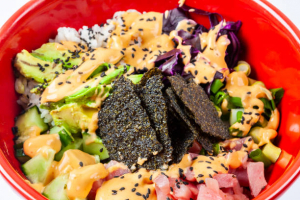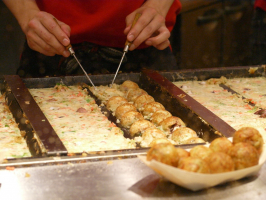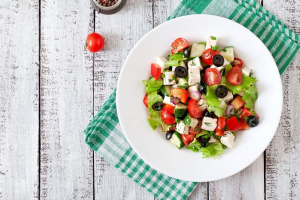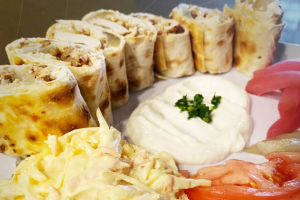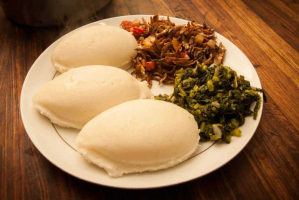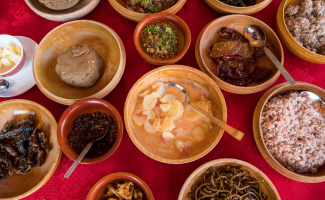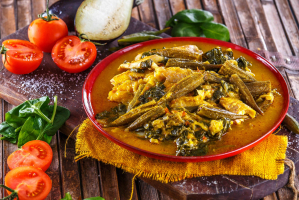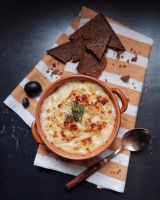Top 12 Best Filipino Foods
Have you tasted Filipino cuisine? I'm not shocked if you haven't because, for whatever reason, Filipino cuisine hasn't taken off as much as other Asian ... read more...cuisines such as Japanese, Korean, Vietnamese, or Thai. Filipino cuisine is distinguished by the blend of three flavors: sweet, sour, and salty. If you're planning a trip to the Philippines and want to get a taste of the local cuisine, Toplist hopes the list of the Top 12 greatest Filipino cuisines will point you in the right direction.
-
Chicharon is a deep-fried pork rind snack popular in many Spanish-speaking countries. It also refers to that in the Philippines, although it can also apply to other similarly deep-fried foods made with either pork or chicken. Chicharon bituka, which refers to swine intestines sliced into bite-sized pieces and deep-fried, is one of the most common examples of chicharon in the Philippines. Manok chicharon (chicken skin) Chicharon is a type of deep-fried chicken skin. Although it is actually a form of chicharon, most Filipinos just refer to it as "chicken skin."
It's difficult not to enjoy anything crispy and deep-fried, but the favorite sort of chicharon is chicharon bulaklak. It is a form of chicharon produced from pork mesentery. The mesentery is a thin, web-like membrane that surrounds and protects the small intestine. When the mesentery is removed, it resembles a flower with a frill or ruffle-like decoration. Chicharon bulaklak translates as "flower chicharon."
My favorites are chicken skin and chicharon bulaklak, but deep-fried pork rinds are the most popular and widely accessible variety of chicharon in the Philippines. People will assume you're looking for deep-fried pork rinds if you say "chicharon." They are typically available in two varieties: with and without fat. Chicharon with fat tastes considerably better, but it is also much more sinful.
Chicharon, regardless of style, is generally served with vinegar to help cut the fat and add a wonderful sour kick. It's frequently served as a snack or as part of a bar chow dish with beer.
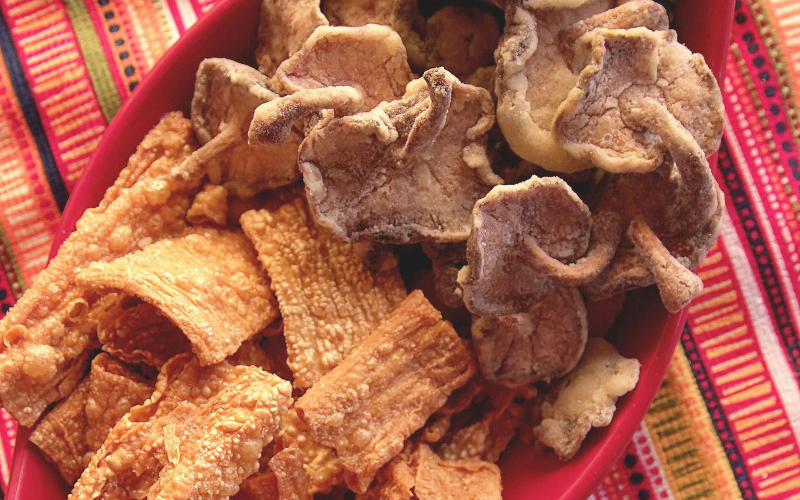
onegreenplanet.org 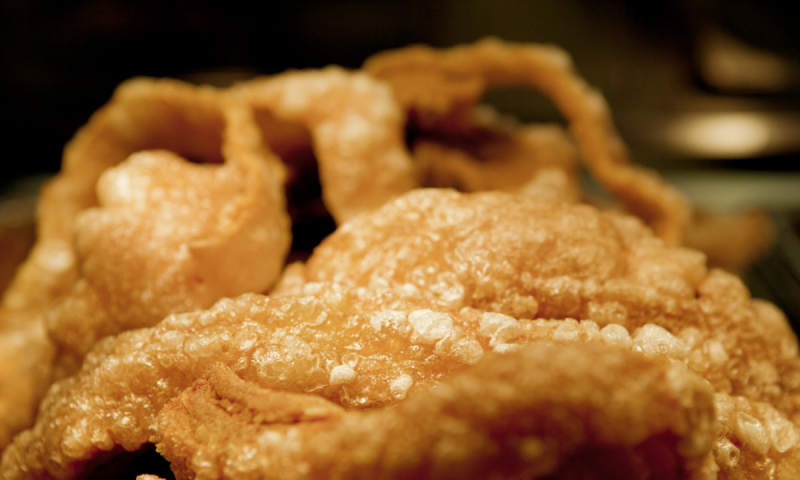
delishably.com -
If you could only try one dish in the Philippines, one dish to represent Filipino cuisine, Toplist will probably recommend pork sisig. It's a popular bar chow dish made of chopped hog face, ears, and chicken liver served on a sizzling cast iron pan.
Sisig originated in Pampanga province, which is the (unofficial) gastronomic capital of the Philippines, but it has spread throughout the country. It was invented in the mid-1970s by Aling Lucing's restaurant in Angeles City, when a glut of waste pig's heads from a former US air base inspired her to create the meal.
The pig's head is boiled, roasted, and grilled before being sliced and seasoned with vinegar and calamansi juice. It's served on a sizzling cast iron dish with chopped onions and chicken liver to protect the fat from freezing cold and turning into grease. Sisig is usually prepared with pork, however you can now get variants made with various proteins such as tuna, squid, mussel, or oyster. There are more exotic variations made with crocodile or ostrich, but pork sisig is still the greatest and should be tried.
Recipes vary by region, thus it's not uncommon to encounter sisig cooked with mayonnaise, raw egg, ox brain, and chicharon chunks. It's typically served as a shared appetizer or bar chow meal.
Pampanga is known as the sisig capital of the Philippines, thus it's still the finest place to try it. The original Aling Lucing's restaurant is still open, although great sisig can be found throughout the Philippines. If you're in Manila, Toplist recommends trying it at the Trellis restaurant. It is owned by a well-known Kapampangan culinary family that is credited with popularizing sisig in Manila.
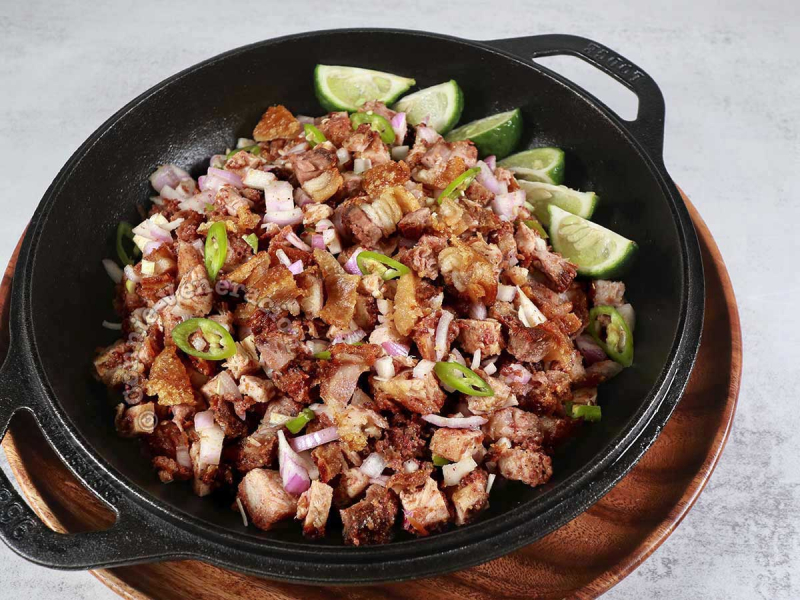
devour.asia 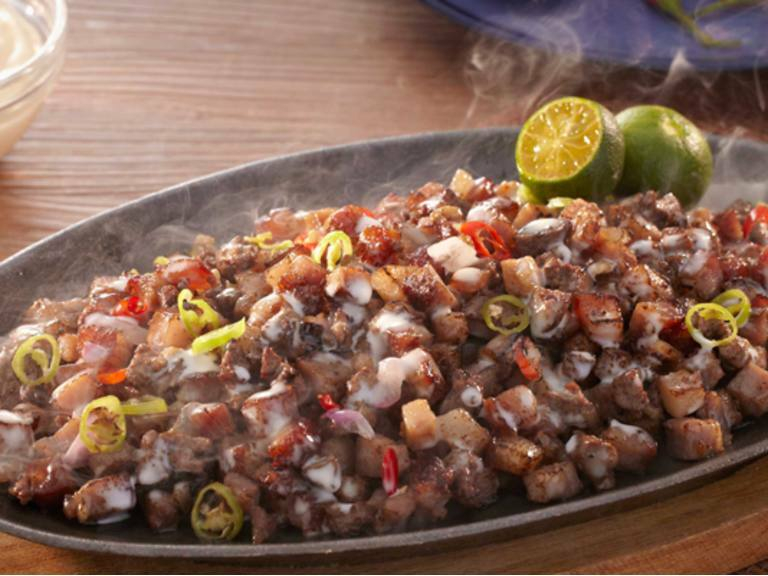
ladyschoice.com.ph -
Lumpia is the Filipino equivalent of spring rolls. It's a famous Filipino dish that's frequently served as an appetizer at parties, gatherings, and sit-down family meals. A thin paper-like crepe stuffed with a variety of ingredients is used to make Filipino lumpia. It is typically deep-fried, but fresh versions known as lumpiang sariwa are also popular. Lumpiang sariwa literally translates to "fresh lumpia" and is extremely similar to Fujianese/Teochew-style popiah, which has become popular in many Asian nations such as Taiwan, Malaysia, Thailand, and Singapore.
Lumpia is a popular dish in the Philippines that comes in a variety of shapes. One of the most common is Lumpiang Shanghai. It's usually stuffed with sautéed ground pork, onions, carrots, raisins, and other veggies. It did not originate in Shanghai or anyplace else in China, despite its name.
Lumpia can be created with almost any component and usually takes the name of the major ingredient. Lumpiang ubod (heart of palm), lumpiang tinapa (smoked fish), and lumpiang togue are some of the most popular forms of Filipino lumpia (bean sprouts).
Lumpia with cheese or stuffed long green pepper is frequently found in Filipino bars. Lumpia produced with cheese is commonly referred to as "cheese sticks," but lumpia made with pepper is referred to as "dynamite." Deep-fried Filipino lumpia, no matter what it's made from, is commonly served with a vinegar-based dipping sauce or banana ketchup.
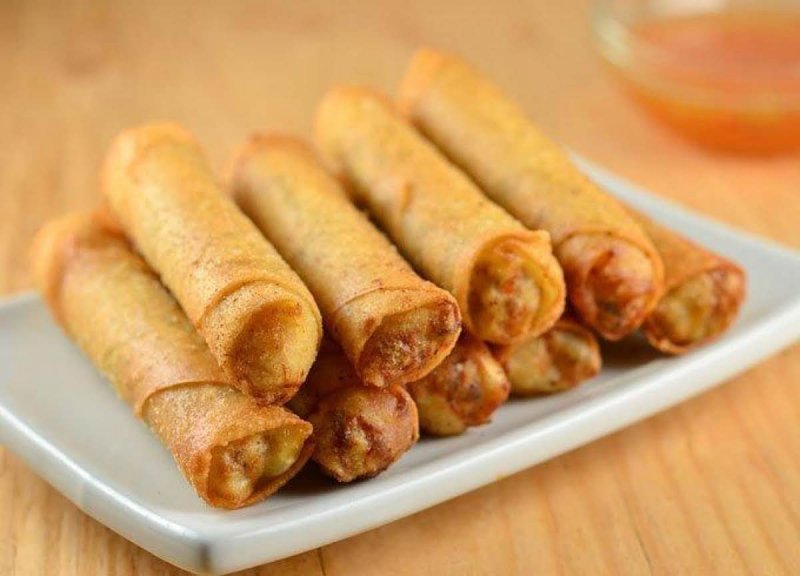
justapinch.com 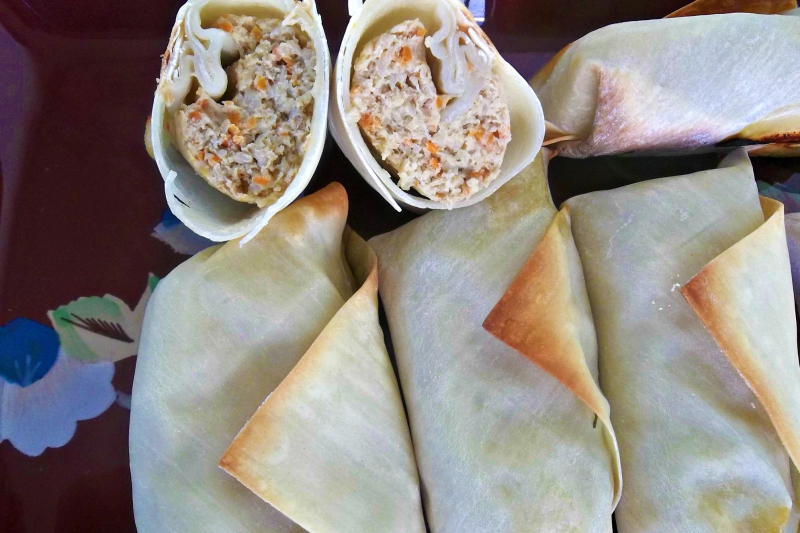
food.com -
Manga at bagoong is a simple but extremely popular meal made with unripe green mango and bagoong alamang. Bagoong alamang is a fermented shrimp or krill paste. Bagoong alamang is prevalent in Southeast Asia in similar forms and is noted for being an exceptionally pungent condiment used in many classic Filipino meals such as pinakbet and binagoongan.
In order to prepare, brine and salted tiny shrimp or krill are brined and salted before fermenting for 1-3 months. This fermenting process produces patis, or fish sauce, which is another commonly used component in Filipino cuisine. A fish-based form of bagoong (bagoong balayan) can also be created by fermenting salted anchovies, as previously described.
Green mangoes with bagoong alamang are a popular snack sold as street food in the Philippines. Some individuals prepare their own bagoong, but bottled versions are widely available in shops, allowing you to enjoy manga at bagoong at home.
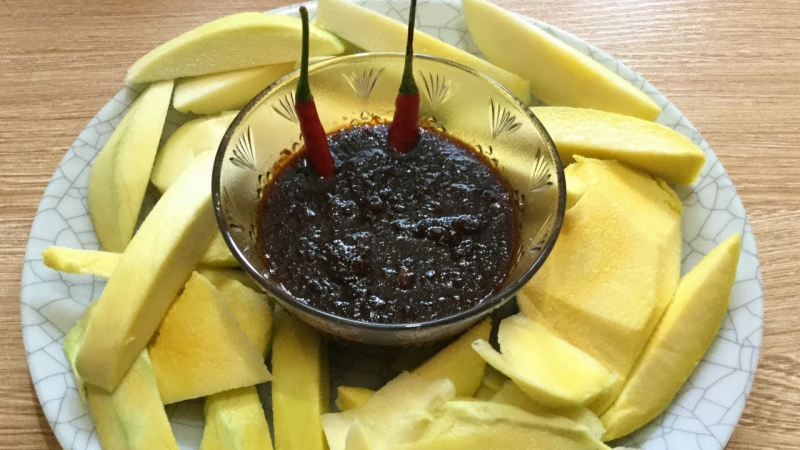
Photo: Lou Craves's Youtube Channel 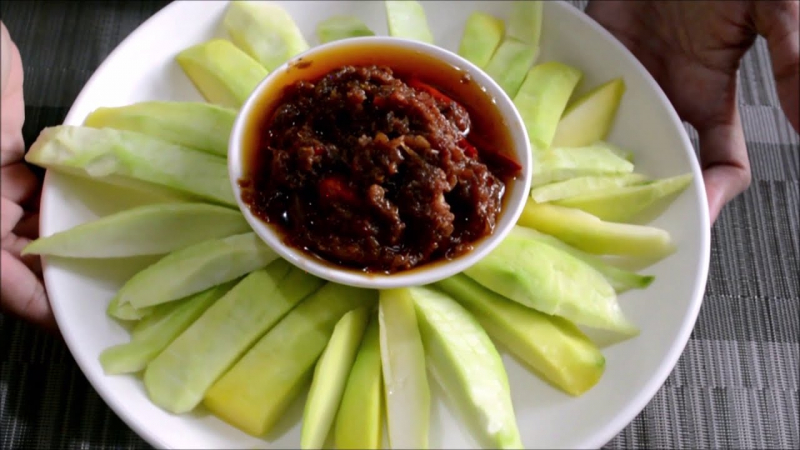
Photo: Ji’s Kitchen's Youtube Channel -
Balut is a well-known dish in this cuisine guide. Even if you've never eaten Filipino food, you've probably heard of balut. It refers to a fertilized duck egg embryo that has been incubated for 14-21 days before being boiled and eaten directly from its shell. Balut is made up of four parts: the "soup," the yolk, the embryo, and the albumen, which is typically too tough to eat. Balut containing embryos in various stages of development can be found depending on how long it was cultured before being cooked. It is stated that the ideal incubation period is seventeen days. Except for its developing feathers, the embryo is utterly mushy and unidentifiable at that time.
Having said that, it's not unheard of to receive balut that's been incubated for a longer period of time. Those will have significantly larger embryos that look like ducklings. They're still soft and edible, but their beaks may have hardened and you'll have to spit them out. You may also come across a variant of balut known as "penoy." These are the balut eggs that did not mature adequately after 9-12 days. Balut penoy is similar to a hard-boiled egg in that there is no separation between the yolk and egg white, similar to a semi-scrambled egg still in its shell.
Balut is a popular Filipino street meal that is high in protein and calcium. If you find these difficult, don't be concerned; many Filipinos do as well. Balut is commonly seasoned with salt and/or a chile, garlic, and vinegar mixture before eating. Some restaurants will even offer them in a more sophisticated manner these days. They can be served in adobo, on hot skillets, and even in a souffle.
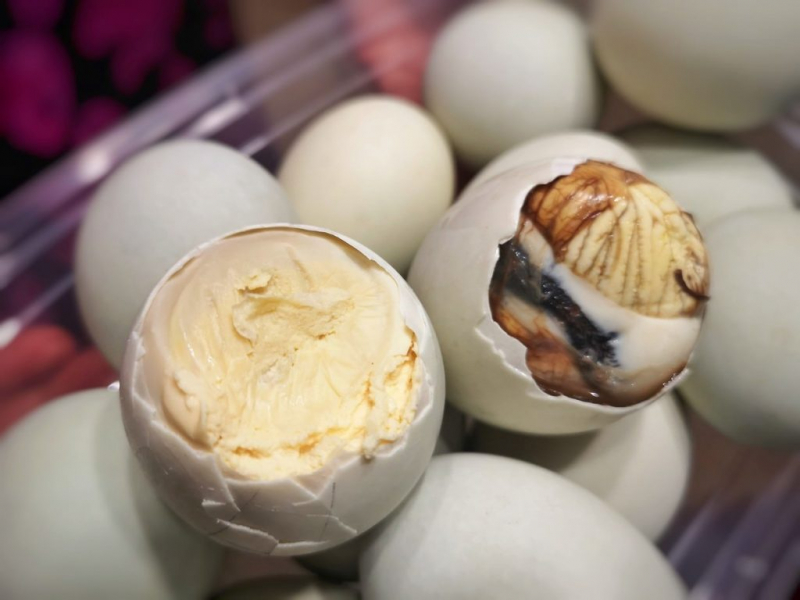
streetfoodguy.com 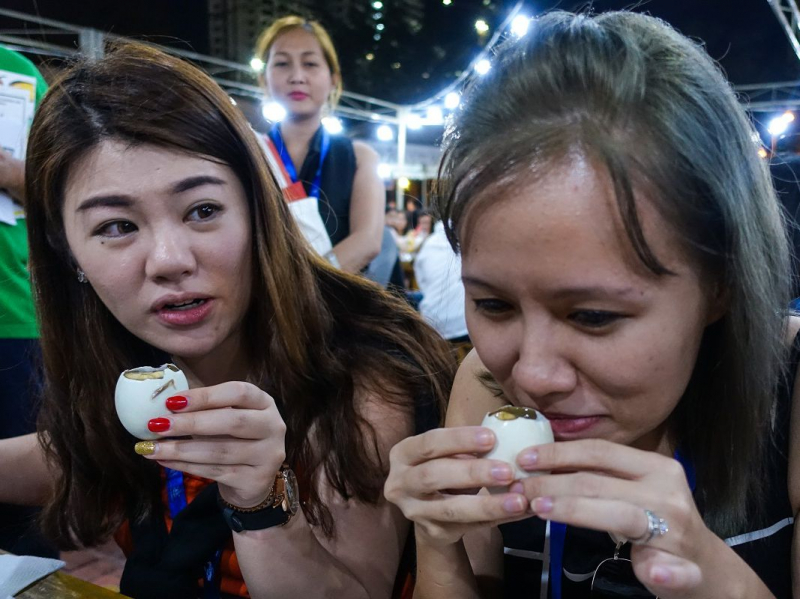
poultryfeedformulation.com -
Longganisa is a Filipino sausage that is derived from the Spanish term longaniza. It is one of the most prominent dishes in Filipino cuisine, with hundreds of variations found around the country. Longganisa is so famous and important in Filipino cooking that many regions conduct annual festivals to commemorate and promote it.
Longganisa is widely eaten for breakfast as longsilog and is typically cooked with pork. It's served for breakfast with sinangag (garlic fried rice), a fried egg, atchara (pickled green papaya), and a vinegar dipping sauce. There are many variants, but they usually fall into one of two broad categories: de recado and hamonado. De recado sausages are savory, and hamonado longganisas are savory-sweet.
The following are some of the most well-known types of longganisa in the Philippines.
- Vigan Longgnaisa (de recado)
- Lucban Longganisa (de recado)
- Calumpit Longganisa (de recado)
- Alaminos Longganisa (de recado)
- Tuguegarao Longganisa (de recado)
- Cabanatuan Longganisa (de recado or hamonado)
- Pampanga Longganisa (hamonado)

foxyfolksy.com 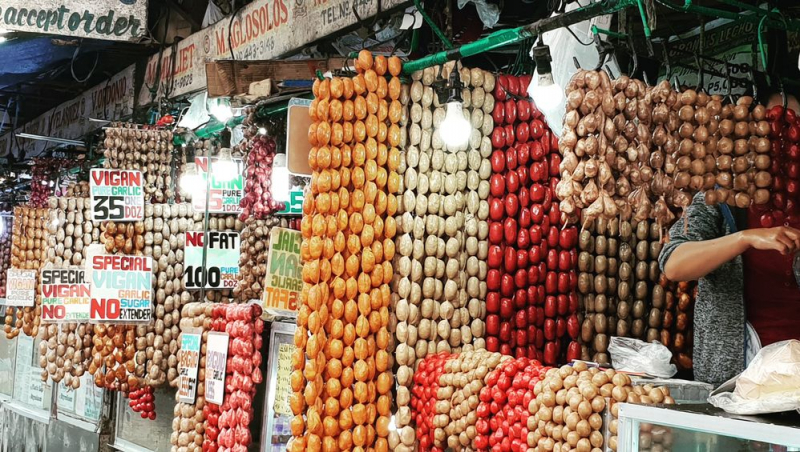
localguidesconnect.com -
One of the favorite Filipino comfort dishes is chicken inasal. It refers to chicken marinated in calamansi, vinegar, pepper, and achuete before grilling over charcoal and basting with the marinade. Chicken inasal originated in Bacolod City in the western Visayas region, but it has now spread throughout the Philippines.
Consider chicken inasal to be a variation on lechon manok. Inasal, on the other hand, is sliced into pieces and impaled on bamboo sticks before being grilled, as opposed to lechon manok, which is spit-roasted whole. When served in a restaurant, you can order it by part – for example, paa (thigh), pecho (breast), pak-pak (wings), or isol (leg) (butts).
Chicken inasal is typically served with white rice with a dipping sauce of vinegar, soy sauce, chili pepper, and calamansi. A bottle of chicken oil, which you can pour over your rice and/or incorporate into your dipping sauce, should be available at every table in a good inasal restaurant.
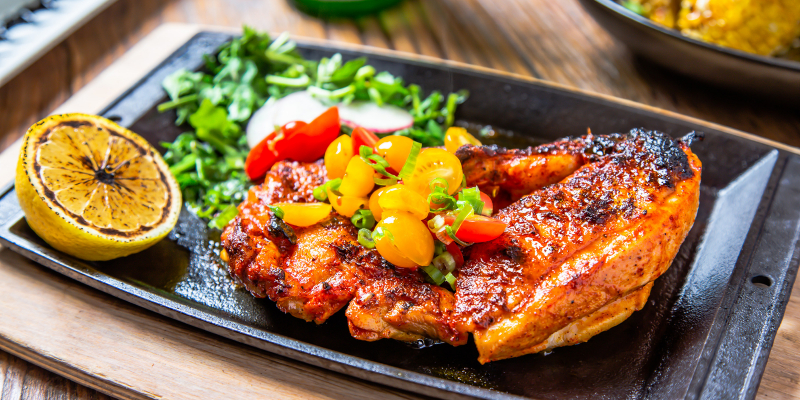
today.com 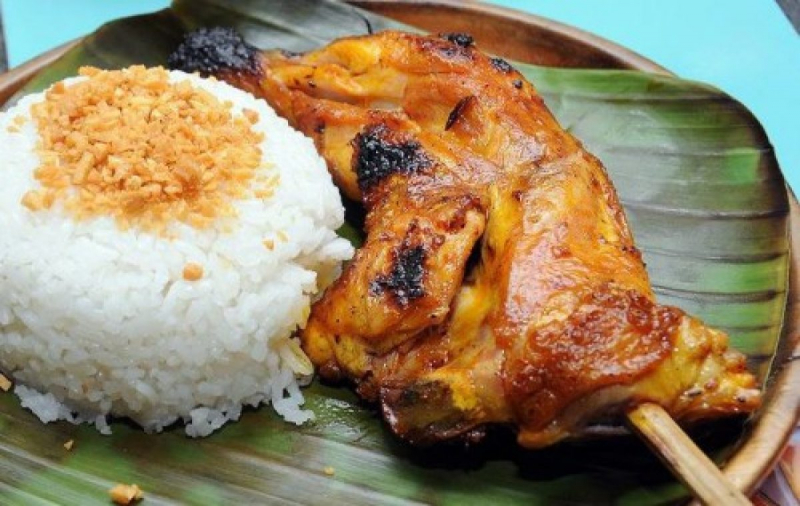
lutongbahayrecipe.com -
Adobo is one of the most well-known Filipino dishes, and it is possible that it is the most important meal on the list. It is sometimes recognized as the national dish of the Philippines. The term adobo, like sinigang, can apply to both the food and the cooking method. Adobo is made by marinating meat, fish, or vegetables in a braising mixture of vinegar, soy sauce, black peppercorn, bay leaves, and garlic. It's often made with chicken and pork that are simmered in a thick, fragrant sauce over low heat until they break down and become fork-tender.
Although the name adobo is derived from the Spanish verb adobar, which means "to marinade," the food or cooking process was not invented by the Spaniards. It dates back to the pre-Hispanic period, when early Filipinos cooked their chicken and pork by soaking it in vinegar and salt, most likely for preservation. The dish was named by Spanish invaders who witnessed the cooking process and referred to it as adobo de los naturales, or "adobo of the native peoples."
Though chicken and pork adobo are the most frequent, there are several variations. They can be served as a main dish with rice or as a side dish, depending on the ingredients. Some of the most popular types of adobo in the Philippines are listed below.
- Chicken and Pork Adobo
- Adobong Pusit
- Adobong Kangkong
- Adobong Puti
- Adobong Dilaw
- Adobo sa Gata
- Adobong Pula
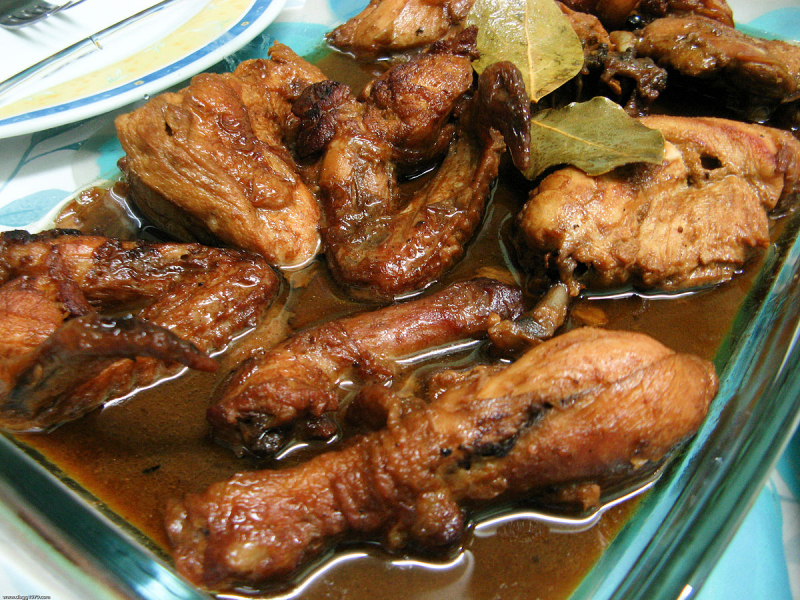
en.wikipedia.org 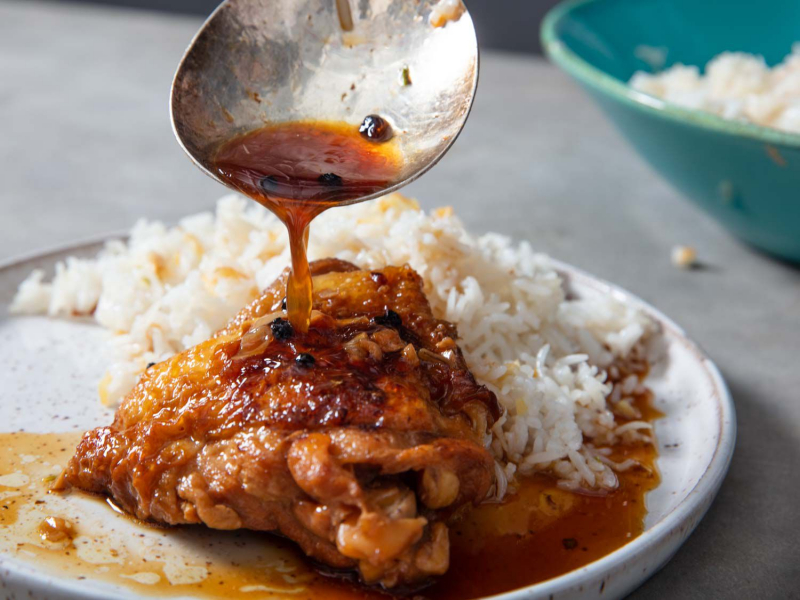
seriouseats.com -
Kinilaw is the Filipino equivalent to ceviche. The word refers to both the meal and the method of preparation, which involves curing raw fish in vinegar and/or citric fruit juices. It's typically cooked with fish such as tanigue (wahoo), bangus, or tambakol (yellowfin tuna), but it can also be made with squid, shrimp, clams, and oysters.
Cubes of raw fish are combined with vinegar and a souring ingredient such as calamansi, kamias, or tamarind to make this dish. Before serving as an appetizer or bar chow, it is generally seasoned with ginger, onions, chili pepper, sugar, salt, and pepper.
When visiting the Philippines, you may hear the term kilawin. Kinilaw and kilawin are occasionally used interchangeably, however kilawin refers to a different but related meal. Kilawin is made by marinating cooked meats such as hog, goat, or cattle in a vinegar mixture, whereas kinilaw is fresh fish that has been cured in vinegar.
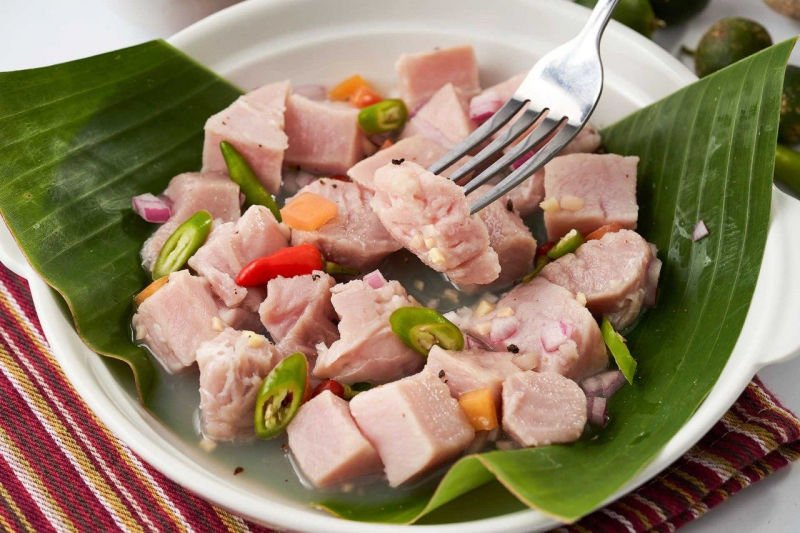
asianfoodnetwork.com 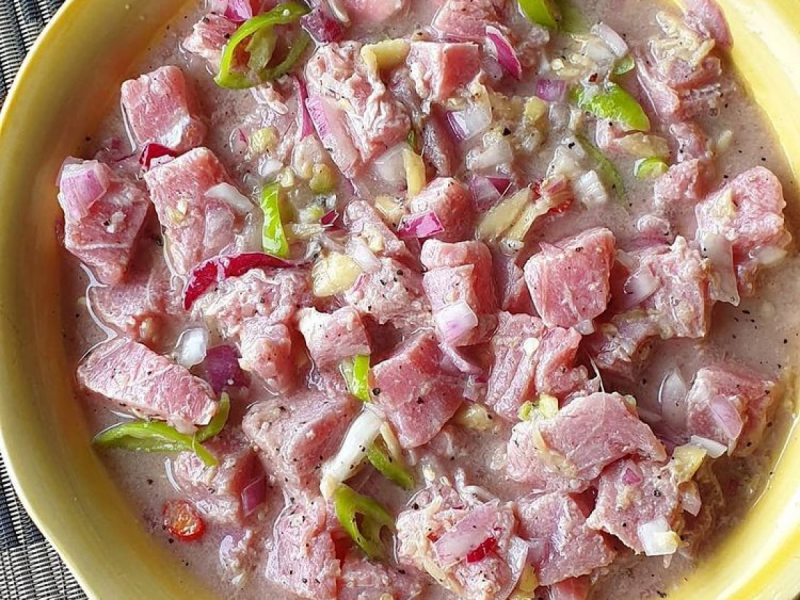
lutongpinoyrecipe.com -
Silog is a sort of Filipino morning food that consists of some type of meat, garlic fried rice, and a fried egg. The meal takes the name of the meat it's made with, therefore tapsilog is silog made with tapa (cured beef). Tapsilog is a combination of tapa (cured beef) and sinangag (garlic fried rice) (egg).
Tapsilog and its variants are popular breakfast dishes in the Philippines. They're often eaten for breakfast, like Malaysian nasi lemak, although they can also be enjoyed throughout the day. There are several silog variations, such as cornsilog (corned beef), bangsilog (bangus), spamsilog (SPAM), and hotsilog (hot dog), but the three most popular are tapsilog, longsilog (longganisa), and tocilog (tocino). Silog dishes, regardless of kind, are typically served with a vinegar dipping sauce.
Tapsilog is pitcured below. It was the initial variant of silog and is made using fried or grilled cured beef. It can be savory, slightly sweet, or spicy, depending on the cook. Tapsilog is so ubiquitous that it may be found almost anywhere - in Filipino homes, restaurants, hotels, and fast food establishments.
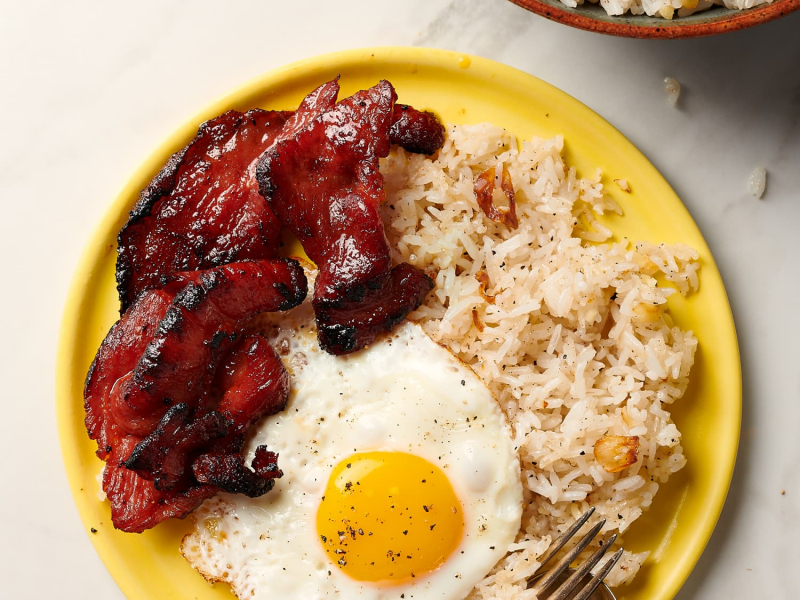
thekitchn.com 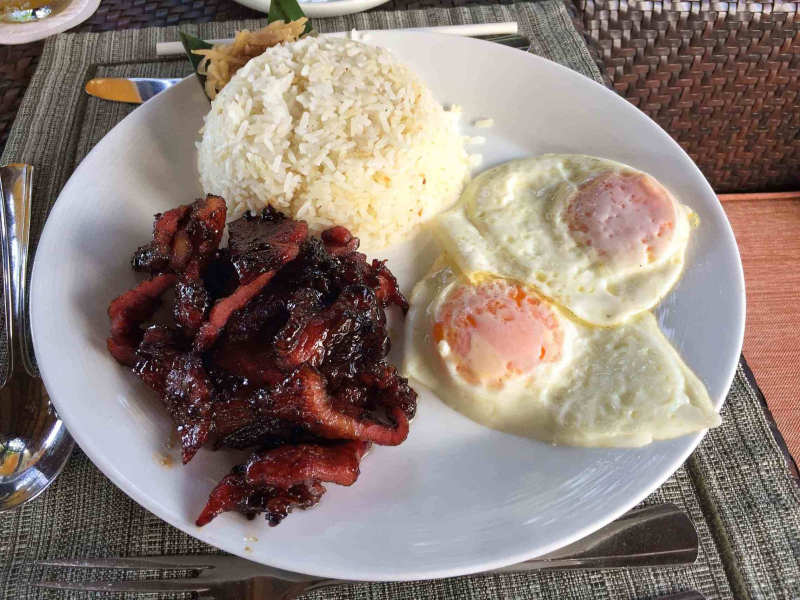
foodicles.com -
Kakanin is one of the favorite Filipino foods, or family of dishes. It's an umbrella name for a variety of desserts and snacks prepared with galapong or sticky rice paste. The word "kakanin" comes from the word "kanin," which means "rice." Consider it the local equivalent of Malaysian or Indonesian kuih.
Kakanin is brightly colored and frequently connected with Filipino festivities and holidays. They can be found in a variety of shapes, sizes, colors, and forms throughout the Philippines. Many are difficult to produce, therefore they are typically reserved for special occasions or festivals.
In the Philippines, there are dozens of kakanin variants, but some of the most well-known and popular include puto, suman, bibingka, kutsinta, biko, espasol, and palitaw. Puto, the most prevalent type of kakanin, is depicted below. This bite-sized steamed rice cake is typically white (putong puti), but it can be colored to signify the flavor. Puto created from ube (putong ube) is a deep purple, whilst puto made from pandan (putong pandan) is green. The puto below is made with cheese (putong queso), which accounts for the yellowish color.
Although kakanin is a broad noun, puto alone includes numerous versions. Aside from the kinds already stated, some of the most popular puto varieties are puto bumbong, puto maya, putong pula, and puto kutsinta. Puto can be eaten alone or with savory foods such as dinuguan.
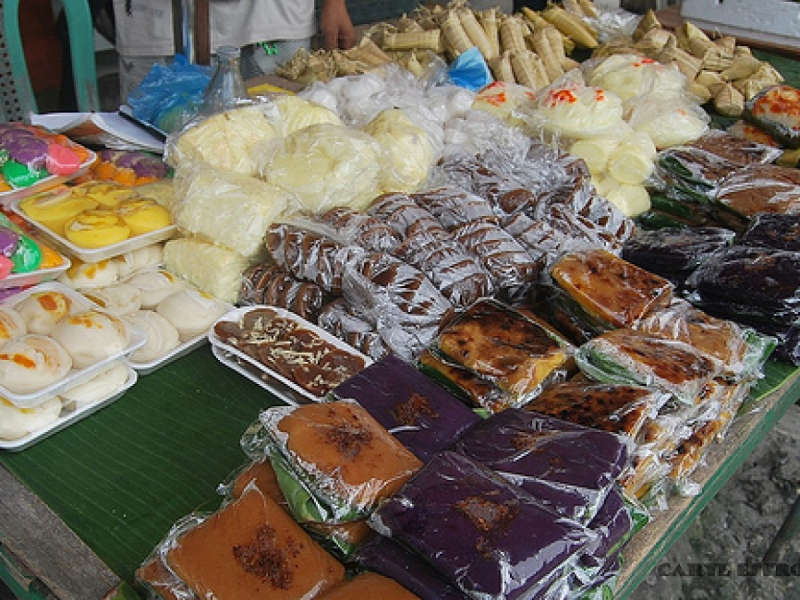
businessdiary.com.ph 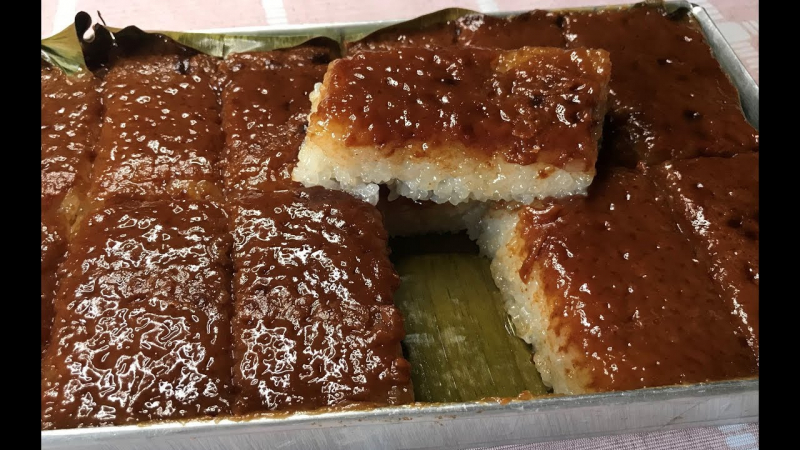
thepoortraveler.net -
In this Filipino culinary guide, halo-halo is maybe the most popular and well-known dessert. Halo-halo is a crushed ice dish made with evaporated or condensed milk and a variety of ingredients such as sweetened beans, ube, coconut strips, kaong (sugar palm fruit), macapuno (young coconut), leche flan, and sugar-sweetened plantains, among many others.
Halo-halo is frequently served in a tall parfait glass so that the multicolored layers of ingredients can be seen. To assemble, put the various ingredients in the glass before covering with crushed ice and topping with leche flan and/or ube (either halaya or ice cream). Before serving, evaporated or condensed milk is poured into the glass of halo-halo.
There is no preset outcome.
Because there is no predetermined set of ingredients in halo-halo, the ingredient combinations will vary from restaurant to restaurant. Many Filipinos believe that the more vivid the halo-halo, the better. Therefore, if you visit Philippines, try it.

wiki-travel.com.vn 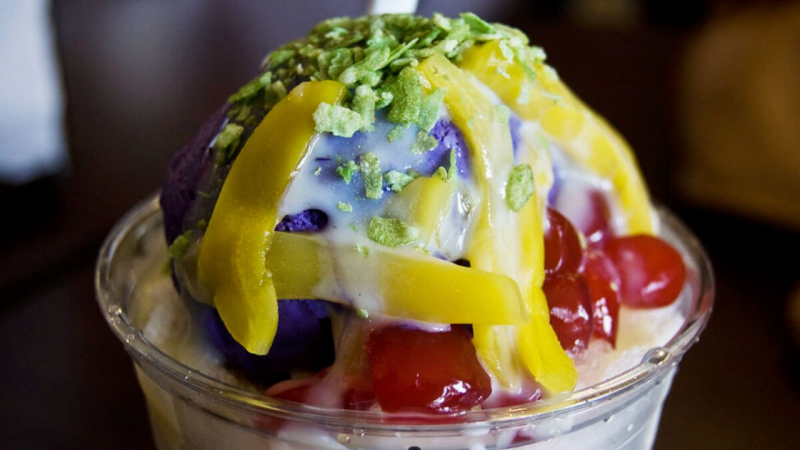
sunnysidecircus.com















